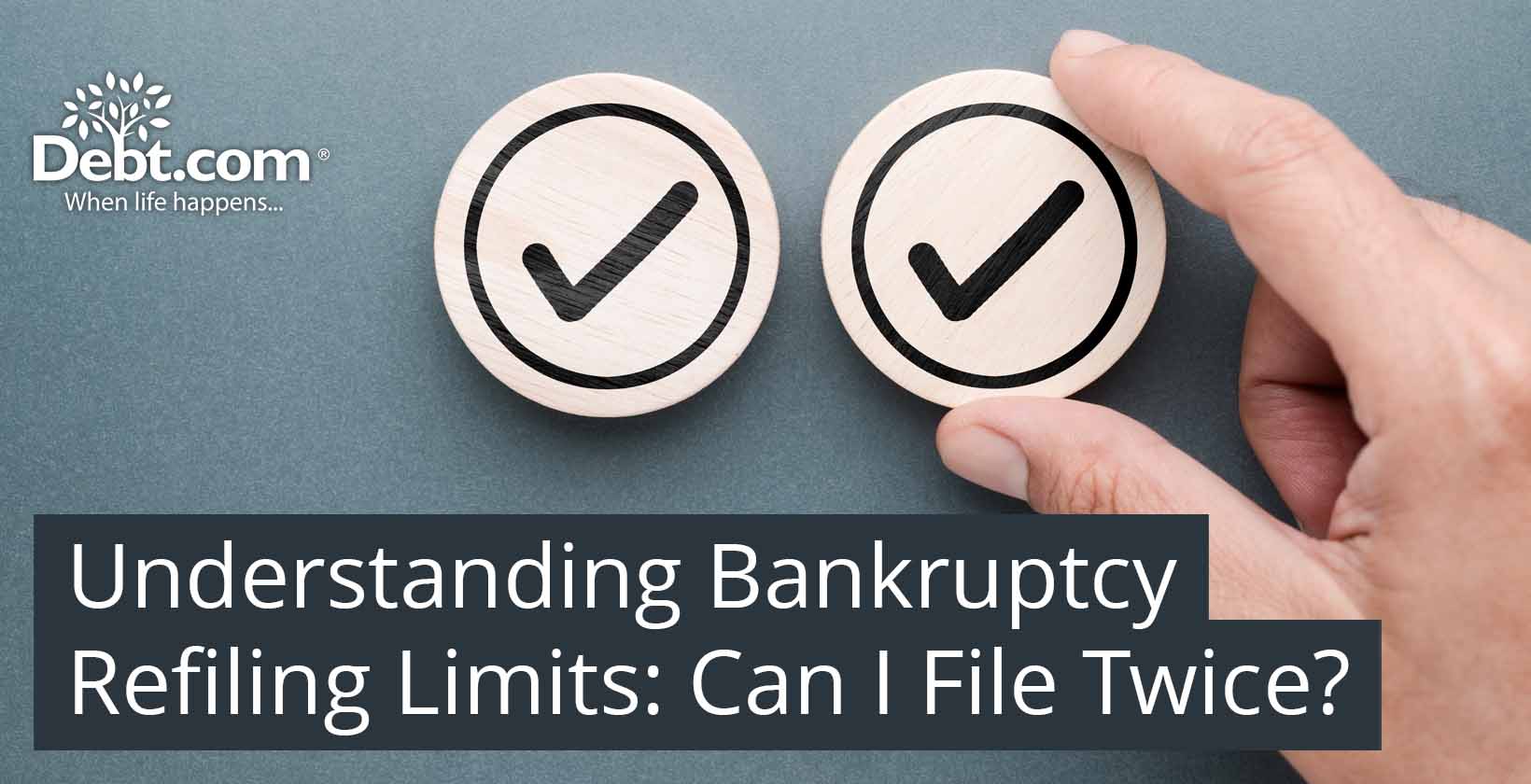
Understanding Bankruptcy Filing Limits
Bankruptcy offers a fresh start for many, but it’s not a decision to be taken lightly. Filing for bankruptcy can have significant legal and financial implications. Federal law imposes specific waiting periods between filings to prevent misuse and ensure fairness to both debtors and creditors. These waiting periods aim to strike a balance between providing individuals with an opportunity to rebuild their finances and ensuring responsible debt management. By understanding these limitations, you can approach bankruptcy strategically, avoid potential legal pitfalls, and increase your chances of a successful outcome.
Navigating these rules can be complex. However, educating yourself on the specific filing limits for different types of bankruptcy will help you make informed choices that align with your long-term financial goals. Remember, financial recovery is a journey that extends beyond the bankruptcy filing itself. It’s about establishing long-term financial stability and building a secure financial future.
Why Bankruptcy Timing is Critical
Timeframes between bankruptcy filings aren’t arbitrary. They’re designed to balance fairness for creditors with the need to provide individuals in financial distress a pathway toward recovery. Misunderstanding these intervals could result in dismissals, wasted effort, and even financial penalties. The time you spend recovering after filing can be crucial for rebuilding your financial foundation and adopting healthier financial habits. Beyond legal restrictions, strategic timing enhances the impact of bankruptcy. For example, filing too early might limit your ability to discharge certain debts or fully benefit from exemptions. Conversely, waiting too long could escalate financial struggles unnecessarily. The art of filing bankruptcy effectively lies in aligning your timing with your broader financial goals and life circumstances
Table of Contents
Chapter 7 Bankruptcy: Timing and Frequency
Waiting Periods After Filing Chapter 7
If you’ve previously filed for Chapter 7 bankruptcy, the law requires you to wait at least eight years before filing another Chapter 7 case. This waiting period ensures that the bankruptcy system isn’t used as a revolving door for debt relief. It’s important to note that the waiting period starts from the filing date of your initial case—not the discharge date.
During this waiting period, focus on rebuilding your financial health. Prioritize creating and adhering to a realistic budget, paying down non-dischargeable debts (such as student loans and taxes), and addressing any underlying financial habits that may have contributed to your previous bankruptcy.
Additionally, take advantage of educational resources offered by nonprofit credit counseling agencies. These organizations can provide workshops, webinars, and one-on-one coaching to help you manage your finances effectively. Building a solid financial foundation during this waiting period ensures that you’re better positioned to avoid future debt crises.
Filing Chapter 13 After Chapter 7
Switching from Chapter 7 to Chapter 13 can provide flexibility. If you’ve received a Chapter 7 discharge and still face financial challenges, you may file for Chapter 13 after a four-year waiting period. This strategy, often called a “Chapter 20,” allows you to reorganize remaining debts and create a manageable repayment plan.
The “Chapter 20” approach is particularly beneficial for addressing secured debts such as mortgages or car loans that were not discharged in your previous Chapter 7 filing. It can also help you manage other outstanding obligations that may have arisen since your initial bankruptcy.
Consulting with an experienced bankruptcy attorney is highly recommended. They can provide expert guidance, help you navigate the complexities of the legal process, and ensure you’re maximizing your available protections.
Chapter 13 Bankruptcy: Timing and Frequency
Consecutive Chapter 13 Filings
Chapter 13 bankruptcy has a shorter waiting period, allowing you to file a new case just two years after your previous Chapter 13 filing date. This quicker timeline reflects the purpose of Chapter 13 as a debt reorganization tool rather than a complete discharge like Chapter 7.
This option is ideal for individuals with steady income who need more time to manage their debts. By adhering to the repayment plan and maintaining regular income, you can use Chapter 13 to gradually regain financial stability.
Understanding the benefits of Chapter 13 is crucial. This type of bankruptcy focuses on debt repayment rather than discharge, making it a valuable tool for individuals with consistent income who are struggling to keep up with high-interest debts. The two-year waiting period ensures that you can continue addressing your financial challenges without undue delays.
In many cases, Chapter 13 also allows you to address specific types of debt—like tax obligations or delinquent mortgage payments—that might not be manageable under other types of bankruptcy. By providing a structured repayment plan, it gives debtors the opportunity to resolve these obligations while maintaining some level of financial stability.
Furthermore, Chapter 13 can prevent foreclosure or repossession of essential assets, such as your home or car, by allowing you to catch up on missed payments over time. This safeguard ensures that your essential assets remain protected while you work toward financial recovery.
Filing Chapter 7 After Chapter 13
Switching from Chapter 13 to Chapter 7 requires a six-year gap from the original Chapter 13 filing date. However, exceptions exist: if you repaid at least 70% of your unsecured debts through your Chapter 13 repayment plan, you may qualify to waive the six-year rule.
This flexibility rewards significant repayment efforts, allowing quicker access to Chapter 7 if financial circumstances worsen. It’s another reason why strategic planning is essential when navigating bankruptcy options. Consider consulting with a bankruptcy attorney to explore whether you meet the criteria for these exceptions and to develop a plan that aligns with your long-term financial goals.
Understanding these options ensures you’re taking full advantage of the legal framework designed to help individuals manage overwhelming debt. Whether you’re addressing secured or unsecured obligations, careful timing and planning can enhance your chances of achieving financial stability. Building a strong support network that includes financial and legal professionals can make this process smoother and less stressful.
| First Filing | Second Filing | Time Required |
|---|---|---|
| Chapter 7 | Chapter 7 | 8 years from the first filing date |
| Chapter 7 | Chapter 13 | 4 years from the first filing date |
| Chapter 13 | Chapter 13 | 2 years from the first filing date |
| Chapter 13 | Chapter 7 | 6 years from the first filing date* |
*There is an important exception to this rule that you should not. If you paid off all your unsecured debt in full or at least paid off 70 percent of the claims made on a plan entered into in good faith, then you can file for Chapter 7 sooner than this date.
Need help starting the filing process? We’re here so you can get the fresh start you need.
Why Timing Matters When Filing Bankruptcy
Strategic timing can make or break your financial recovery. Filing too soon can lead to dismissal or wasted resources. Waiting the required timeframes, on the other hand, helps you:
- Rebuild your credit score for better financial opportunities.
- Reassess your financial situation and explore alternatives to bankruptcy.
- Avoid penalties for premature filings.
- Fully recover from the financial and emotional toll of bankruptcy.
Timing also plays a role in protecting your assets. For example, by waiting to file, you may qualify for exemptions that shield more of your property from creditors. Additionally, the recovery period allows you to rebuild your financial foundation, improving your ability to handle future challenges effectively.
Taking the time to prepare also strengthens your case and increases the likelihood of achieving long-term financial stability. Use this time to seek professional advice, learn more about managing finances, and adopt habits that prevent future financial crises.
Additionally, leveraging financial education resources during this period can enhance your understanding of budgeting, saving, and investing. By developing a well-rounded financial plan, you position yourself for a more secure future while minimizing the likelihood of needing to file bankruptcy again. Building a robust emergency fund and understanding your credit can also add layers of financial resilience.
Common Myths About Bankruptcy Timing
Myth 1: “You Can Only File Once in a Lifetime”
False. While there are strict waiting periods between filings, you can file for bankruptcy more than once. The key is adhering to the mandated timeframes and using bankruptcy strategically.
Many people believe this myth due to the stigma surrounding bankruptcy. However, bankruptcy laws are designed to offer a second chance to those who genuinely need it. By understanding the rules and planning carefully, you can make the most of the opportunities provided by the bankruptcy system.
Myth 2: “You Can File Again Immediately After a Discharge”
Not quite. While you can technically file for bankruptcy again, it’s crucial to understand that you may not be eligible for a discharge of your debts if you file within the required waiting period. Filing prematurely can lead to case dismissal, wasted time, and potentially hinder your ability to effectively resolve future financial challenges.
It’s essential to distinguish between eligibility to file and eligibility for debt discharge. Understanding these distinctions is crucial to avoid costly mistakes and ensure your bankruptcy filing aligns with your long-term financial goals. By educating yourself on the specific waiting periods and eligibility requirements, you can make informed decisions and navigate the bankruptcy process with greater confidence.
Practical Advice for Managing Bankruptcy Filings
Assess Your Financial Health
Before filing again, take a close look at your financial situation. Use tools like:
- Debt-to-Income Calculators to evaluate repayment ability.
- Budgeting Apps to track spending and find areas for savings.
- Credit Reports to identify errors or issues affecting your credit score.
These insights can help you decide whether bankruptcy is the best option or if alternative solutions, like debt settlement or credit counseling, could work instead. Regularly monitoring your financial health ensures that you’re making informed decisions and taking proactive steps to address underlying issues.
Seek Legal and Financial Guidance
While you can file for bankruptcy on your own, consulting a bankruptcy attorney can help you:
- Fully understand your rights and obligations.
- Avoid costly mistakes in paperwork or court procedures.
- Develop a long-term financial strategy post-bankruptcy.
It’s also helpful to seek out financial advisors. They can help you with:
- Advice on rebuilding your credit score.
- Creating a savings plan.
- Setting a budget to minimize future financial risks.
- Offer insights into debt management programs or credit counseling
Together, these professionals provide a comprehensive approach to overcoming debt. Their expertise ensures that you’re leveraging all available tools and resources to secure a stable financial future.
Key Takeaways for Bankruptcy Timing and Planning
Understanding bankruptcy timing is essential for long-term financial success. Keep these points in mind:
- Chapter 7: Wait eight years between filings.
- Chapter 13: Wait two years for consecutive filings or six years when switching to Chapter 7 (with exceptions).
- Strategic timing maximizes recovery, minimizes complications, and improves your financial future.
Bankruptcy presents an opportunity for a fresh start. With careful planning and the right resources, you can rebuild your financial foundation and achieve lasting stability. By understanding the rules, debunking common myths, and seeking professional guidance, you can make informed decisions that align with your unique financial goals. Whether navigating Chapter 7 or Chapter 13, strategic planning and timing are crucial for reclaiming control. With the right approach, you can turn financial adversity into a catalyst for long-term success and secure a brighter future for yourself and your family.
A reader asked the following question
Question: I’ve been working with a debt settlement company since May 2017. They have settled six of my accounts with three more to go.
I chose not to do bankruptcy because it was still showing on my credit report, although it was discharged in 2006. And I didn’t know if I can file again.
How I got to this point was through unfortunate circumstances and bad habits. I’ve been living paycheck to paycheck, so I used payday loans anytime I had an emergency. Then I got a car title loan just to pay other loans. Now I’m stuck with a foolish car title loan until October 2020.
The debt settlement has given me some relief. But I still have quite a bit to go, and I find myself being in the red each month. I have a budget for each pay period, but I still end up using overdraft funds almost every month($500 limit/$28 for each paid item).
Sometimes, I’m over by a $100 and sometimes by $300. It depends on what has happened unexpectedly in that pay period. Those additional fees of $28 each can add up. I’ve cut back all that I can and just pay my bills. I do get an extra $200 a month for keeping my grandchild on weeknight and weekends.
What can I do more to help with my financial difficulties?
Jo in California
Debt.com Howard Dvorkin responds…
Your story is complicated, Jo, but it’s not unusual. For two decades, I’ve seen Americans sink slowly into debt as if it were quicksand. They grab at anything they think will save them. That does slow down the inevitable — but it doesn’t stop it.
I can give you some information that will make it easier to understand all the factors at play here. However, I recommend that you get in touch with someone that can help you understand how all of this applies in your specific financial situation.
#1: The credit report notation for your first bankruptcy should have fallen off years ago.
If you filed for bankruptcy in 2006, then the latest that penalty should have remained on your report is 2016. Even if you filed for Chapter 7, the public record notation should only remain for 10 years.
So, at a minimum, you should contact the credit bureaus to dispute why the item is still showing up on your reports. I recommend going to annualcreditreport.com to check your reports with all three bureaus (Experian, Equifax, TransUnion).
If you don’t know how to make a dispute, Debt.com offers a free guide to help you along.
#2: Enough time has passed that you can legally file bankruptcy again
The maximum amount of time that needs to pass between filings is 8 years. That means you’re well past the point of time required between your first and second discharge. You should be able to file for Chapter 7 or Chapter 13 without the time limit between your filings being an issue.
#3: Debt settlement may not be able to help with your title loan directly
A title loan is a secured type of debt. That means that the lender has the security of your vehicle as collateral if you fail to pay the loan back. If the value of your car is enough to pay off the loan, then they would be likely to repossess your car instead of settling the debt.
However, if you are slowly regaining stability through a debt settlement program, then the program may help you indirectly. If you can complete your settlement program, you may have the means to cover the title loan payments to finish it off by October of this year.
#4: Bankruptcy could save your car in certain situations, but not in others
In Chapter 7 bankruptcy, your assets are liquidated to pay off your debts. The car could be sold to satisfy the title loan. In some cases, you may be able to “redeem” the car by paying its current market value, if that value is less than the amount left on the loan.
But this only works in some circumstances and you generally must make that payment in full. It doesn’t sound like you have the means to do that given your current financial situation.
Chapter 13 bankruptcy may protect your assets from liquidation because you set up a repayment plan. However, there are exceptions that may apply here as well. At the least, filing for bankruptcy triggers an automatic stay, so if you aren’t keeping up with the payments, it could at least help you avoid impending repossession.
The bottom line…
You need to talk to a certified professional that can dive into where your finances are right now. There are a lot of specifics and exceptions to rules that a qualified expert needs to evaluate.
The good news is that you’ve come to the right place. Debt.com works with a network of debt relief service providers, from nonprofit credit counseling agencies to bankruptcy attorneys. We can connect you with a certified debt resolution specialist that will evaluate your situation and match you with the best services for your needs.
If I were to guess, Jo, bankruptcy might once again be your best option. But you need to talk one-on-one with someone first before you decide to file.












